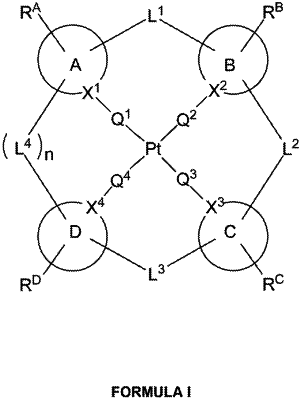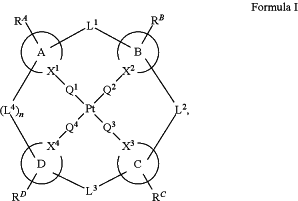| CPC H10K 85/346 (2023.02) [C07D 209/82 (2013.01); C07D 213/69 (2013.01); C07D 233/54 (2013.01); C07D 235/04 (2013.01); C07D 401/12 (2013.01); C07F 7/0814 (2013.01); C07F 15/0086 (2013.01); C07F 15/0093 (2013.01); C09K 11/06 (2013.01); H10K 50/11 (2023.02); C09K 2211/1007 (2013.01); C09K 2211/1029 (2013.01); C09K 2211/1044 (2013.01); C09K 2211/185 (2013.01); H10K 2101/10 (2023.02)] | 20 Claims |

|
1. A device comprising one or more organic light emitting devices, at least one of the organic light emitting devices comprising:
an anode;
a cathode; and
an organic layer, disposed between the anode and the cathode, comprising a host and compound having a Pt tetradentate structure, having the formula:
 wherein rings A, B, C, and D each independently represent a 5-membered or 6-membered carbocyclic or heterocyclic ring;
wherein RA, RB, RC, and RD each independently represent mono, di, tri, or tetra-substitution, or no substitution;
wherein L1, L2, and L3 are each independently selected from the group consisting of a direct bond, BR, NR, PR, O, S, Se, C═O, S═O, SO2, CRR′, SiRR′, GeRR′, and combinations thereof,
wherein when n is 1, L4 is selected from the group consisting of a direct bond, BR, NR, PR, O, S, Se, C═O, S═O, SO2, CRR′, SiRR′, GeRR′, and combinations thereof,
when n is 0, L4 is not present;
wherein RA, RB, RC, RD, R, and R′ are each independently selected from the group consisting of hydrogen, deuterium, halide, alkyl, cycloalkyl, heteroalkyl, arylalkyl, alkoxy, aryloxy, amino, silyl, alkenyl, cycloalkenyl, heteroalkenyl, alkynyl, aryl, heteroaryl, acyl, carboxylic acids, ester, nitrile, isonitrile, sulfanyl, phosphino, and combinations thereof,
wherein any adjacent RA, RB, RC, RD, R, and R′ are optionally joined to form a ring;
wherein X1, X2, X3, and X4 each independently selected from the group consisting of carbon and nitrogen;
wherein one of Q1, Q2, Q3, and Q4 is oxygen, the remaining three of Q1, Q2, Q3, and Q4 each represents a direct bond so that Pt directly bonds to three of X1, X2, X3, and X4; and
wherein when L1, L2, L3, or L4 represents a direct bond, the direct bond is not a C—C bond.
|